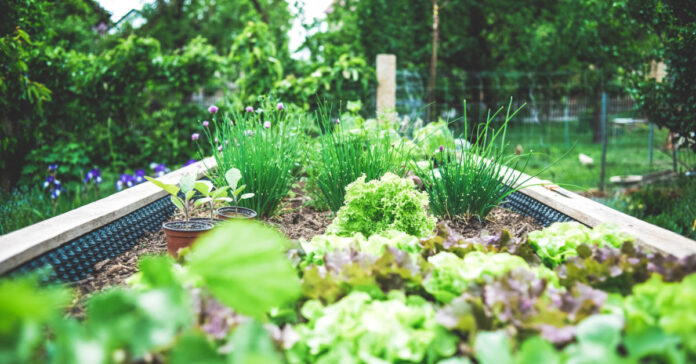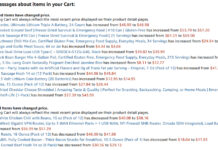In the space of two week’s, we’ve moved from predictions of a food shortage to predictions of a full-blown food crisis in the near future. Zero Hedge is going to far as to predict “agricultural mayhem in the U.S.” If there’s agricultural mayhem, you can darn well bet there will be other kinds of mayhem as well. The kind that ends with buildings burning and people being carried away in ambulances.
The article also points out that exports from the Ukraine and Russia account for “12 percent of all calories traded globally,” a figure I had not heard. This might be a good time to check back and review the article I wrote last week, How to Prepare for the Coming Wheat Shortage. While that article focused on grains, this one is about other things you can do to survive a food crisis.
I’ve been preaching food storage for years, so we’ll skip that and go right to growing your own.
Plant a Small Garden
Many gardeners grow tomatoes and peppers, and those are useful, flavorful garden produce. In fact, we grew both last year. Unfortunately, they do not provide a great deal of calories, making them lesser players in the battle to put calories on your table and fight hunger.
Some of your best bets for feeding yourself and filling your family’s belly are root crops. Potatoes, beets, carrots, turnips, rutabagas, and sweet potatoes are good examples and are calorically dense. In some cases, you can even eat their leaves as you wait for the tubers to mature.
If you don’t have a garden, you can grow potatoes in a five-gallon pail or other large pot. You’ll want more than one pail if you expect to harvest enough to make a dent in your food supply. Some people pile up tires, dump dirt inside, and grow potatoes in there. Search YouTube for videos on how to do this and watch at least four or five. Then pick the idea that best suits your needs.
Leafy greens are another good choice. Go beyond lettuce and plant something more substantial, like spinach, kale, and Swiss chard. There is a plethora of other greens that can provide you needed vitamins and minerals, from mustard to collards. One of the best things about many greens is that you can plant a spring crop in the next month or so and another in the fall. Some, like Kale, are even cold hardy and can stay in the ground well after your tomatoes have died off.
Somewhere between the leafy greens and the root vegetables are members of the cabbage family, which include not only cabbage but Brussel sprouts and broccoli. Like root crops, cabbages can store well.
We’ll be planting several vegetables listed above as well as both summer and winter squash.
For the Larger Garden
While you can grow the above plants in raised beds and small plots, there are some vegetables that are best grown in larger gardens where you can dedicate a few rows to them. This includes corn, beans, and peas. While you can grow enough string beans or peas in a small plot to make a few dinners, you need to plant a larger plot if you want to can up enough to last through the winter.
Field corn is probably the easiest grain to grow, harvest and process on a homestead. Just watch out for the raccoons, they will steal you blind. You may not think you have raccoons, but a patch of corn will bring them out and you will grow to hate their tiny hand-prints when you come across one in your garden dirt. This brings up an important tpic: fencing.
If you are planning to put in a garden, big or small, get fencing materials while you still can. Also, don’t take it for granted that if you plant something it will grow. It might, or it might not. Plants that start strong can get eaten by a bug, killed by a disease, have its roots destroyed by a vole, or fail in many other ways. If you are a beginning gardener, get a good book and watch a few videos, and stay vigilant. You cannot plant it and forget it. Finally, don’t count your calories until you harvest them.
Livestock
This is also a good time of year to consider raisings some small tock. Many urban and suburban communities allow a few chickens but may ban roosters. This is the perfect time to set up a chicken coop and a run while you wait for chickens to come in. You can raise meat birds, egg layers, or dual-purpose breeds that lay eggs but can also be raised for meat.
It’s also easy to raise rabbits in a garage or shed. You don’t even need a backyard. If you do it right, your neighbors won’t even know you have them. (See our post, Are Rabbits the Perfect Livestock for Preppers?) Rabbits remain on our radar screen.
Cultivate Local Growers
If you can’t grow your own food, consider local growers. Go to farmers markets this spring and build relationships with farmers near you. When the grocery store doesn’t have food because of the price of diesel fuel is too high or the big farms didn’t plant due to a lack of fertilizer, your local organic producer will probably still have fresh vegetables. Your local beef man may still be willing to sell you half a cow.
You need to establish those relationships now so you will be on the grower’s short list when the hard times come. That means buy food from them now, when you don’t have to. Consider joining their CSA if they have one. If you can’t get to the point where they know your name, you should at least try to get to the point where they recognize your face.
You can also patronize pick-your-own operations for everything from strawberries and blueberries to pumpkins. But pay attention, the harvest may only last a few weeks. My advice is to make a big haul and then freeze or can the excess.
Self Sufficiency
It’s unlikely that any of us will ever become totally self-sufficient, but we can all do things to increase our self-sufficiency. As prices rise, everything you can bake instead of buy, make instead order online, or grow instead of go without, will make a difference.
Whatever you do, please don’t take the threat of a food crisis casually. This is a serious threat. If you are living paycheck to paycheck, this will wreck your budget. If you have savings, inflation will drain it. A food crisis combine with high inflation and an economic collapse spells bad things for our future. Make sure you are as prepared as you can be.
If the idea of a food crisis or the need to prepare for a changing world is new to you, here are some other posts that may be of use:







